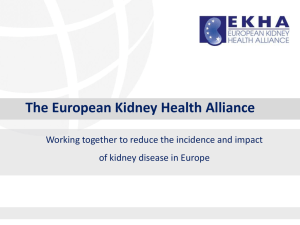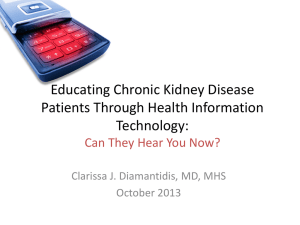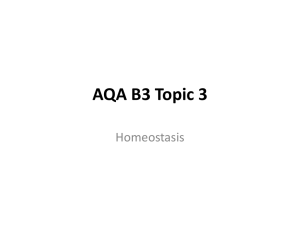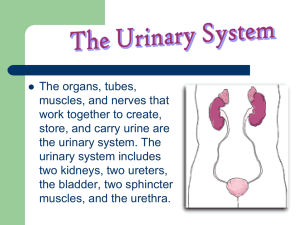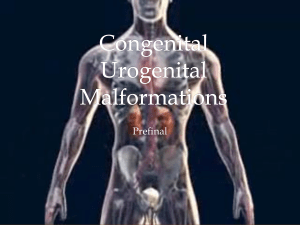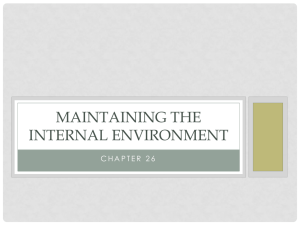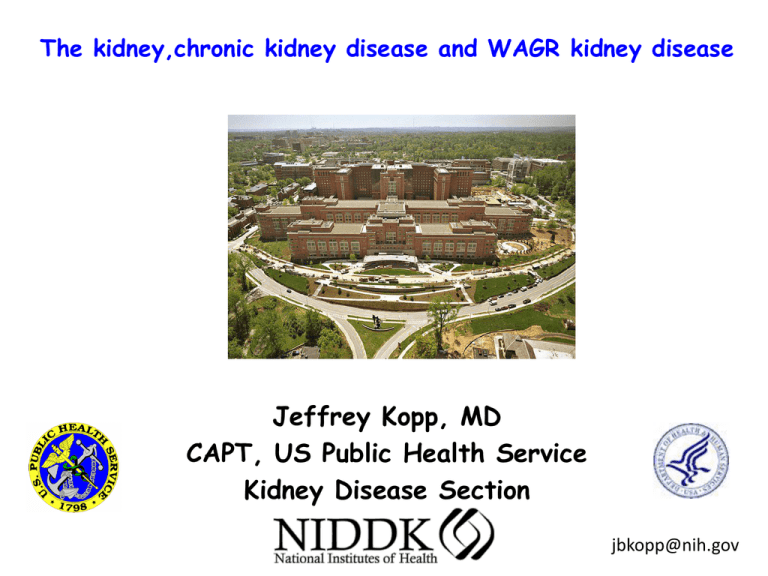
The kidney,chronic kidney disease and WAGR kidney disease
Jeffrey Kopp, MD
CAPT, US Public Health Service
Kidney Disease Section
jbkopp@nih.gov
Kidneys on computerized tomography (CT) scan
Kidneys and what they do (1)
Product
Waste
Cars
Smoke
Homeostasis
Urine
Kidneys came early in animal evolution
1 million nephrons in each kidney:
each is glomerulus + tubule
Glomerular filtration: filtering small molecules
from the circulation
Renal blood flow ~1000 mL/min
Renal plasma flow ~600 mL/min
Glomerular filtration rate (GFR) ~100 mL/min = ~150 L/day
One kidney, one million nephrons
Tubular reabsorption:
reclaiming what we need before it heads down the tubule
to the ureter, bladder, and out
THE GOOD
(unless excess)
Sodium
Potassium
Chloride
Bicarbonate
Calcium
Magnesium
Glucose
Amino acids
Vitamins B, C
etc
THE BAD
Urea
Uric acid
Creatinine
Toxins
etc
Why does the kidney filter everything,
and then reclaim what is needed and
discard the rest?
Keeping the baby, throwing out
the bathwater
Creatinine physiology
Small molecule, released from muscle turnover
Production depends on muscle mass
Freely filtered through the the glomerulus
Serum levels depend upon muscle mass (higher
when muscle mass is higher) and kidney function
(higher when kidney function is poor)
When kidney function is impaired
GFR declines linearly
serum creatinine rises geometrically
Estimating kidney function from serum tests
Gold standard test
• Infuse iothalamate, measure serum and urine levels, calculate
kidney clearance of iothalamate
• Requires IV and takes ~3 hr
Population Name
Variables
Children
Schwartz 1976
Creatnine, height
Schwartz 2012
+ BUN, Cystatin C
MDRD
Age, sex, race,
creatinine
75%
CKD-EPI (2012)
Same
87%
CKD-EPI-Cr/CystC
(2012)
+ Cystatin C
92%
Adults
P30%
40: 28, 52
Chronic kidney disease stages
Stage
GFR
ml/min/1.73m2
Possible
complications
Dose adjustment
for meds excreted
by kidney
1
Normal GFR;
proteinuria or
hematuria
>90
BP
-
2
Mild CKD
60-90
BP
-
3
Moderate CKD
30-60
BP, bone, CVD
+
4
Severe CKD
15-30
BP, bone, CVD,
anemia
++
5
Kidney failure
= ESKD
<15
BP, bone, CVD,
anemia, infection
+++
Assessing urine protein levels
Problem: in a particular patient at a particular phase of
disease, protein concentration in urine fluctuates with urine
concentration from sample to sample
Since the amount of urine creatinine/day is relatively
constant, the concentration in urine provides an index of
urine concentration or dilution
Solution: the protein/creatinine ratio or albumin/creatinine
ratio will adjust for changes in urine concentration
Example of urines taken from the same patient at two different
times of the day
Concentrated urine: albumin 10 mg/dL, creatinine 100 mg/dL =
ACR 100 mg/g
Dilute urine: albumin 2 mg/dL, creatinine 20 mg/dl = ACR 100
mg/g
Assessing kidney function: urine tests
Blood
Protein
Urinalysis dipstick
Negative, Trace, 1, 2, 3
Negative, Trace, 1 ,2, 3
Urinalysis
microscopic
Did the red blood cells
come from the kidney?
NA
Random urine
(children, adults)
NA
Albumin/creatinine ratio (ACR)
30-300 mg/g: microalbuminuria (metabolic syndrome,
early glomerulosclerosis)
>300 mg/g: macroalbuminuria - kidney disease
>1 g/g: nephrotic
Protein/creatinine ratio (PCR)
<0.2 g/g: normal
0.2-2 g/g: proteinuria
>2 g/g: nephrotic
24 hour urine
collection
(adult values)
NA
Albumin
30-300 mg/d: microalbuminuria
>300 mg/d: macroalbuminuria – kidney disease
Protein
>150 mg/d: proteinuria
> 3.5 g/d: nephrotic
WAGR kidney disease
Wilms tumor: CKD is common when there is a
genetic basis
National registry of Wilms tumor, 1969-1995
N = 5965 enrolled at <16 yr
Renal failure: cr>2.5 or dialysis
WAGR
Denys-Drash
Breslow Cancer Res 2000
NIH WAGR study
Genotype/phenotype: relate phenotype to genes deleted
Random urine A/C in 24 subjects
ACR mg/g <10
10-17
18+
<30
5
2
3
30-300
0
4
3
>300
0
2
3
Patterns of WAGR kidney diseases
Immature
podocytes
Diffuse
mesangial
sclerosis
Focal segmental
glomerulosclerosis
Screening for WAGR kidney disease
Screening: yearly BP check, serum creatinine and
cystatin C, urine ACR (and possibly PCR)
Strive to maintain normal body weight: “bigness”
stresses 2 kidneys, more so 1 kidney, and most 1
kidney with glomerulosclerosis
Maintain normal BP: if borderline, restrict dietary salt
(2 g/d target) and check BP at home. BP target is 50th
percentile BP for age and height.
If albuminuria appears, consider kidney biopsy to
confirm that glomerulosclerosis is present (but
probably no biopsy if single kidney)
No role for kidney ultrasound in diagnosing
glomerular disease – will be normal until extensive
fibrosis develops and substantial loss of function has
occurred.
Treatment for WAGR kidney disease
Probably start therapy with renin-angiotensin
pathway blockers – one drug and possibly two
drugs
This approach slows glomerulosclerosis in other
diseases but has not been tested in WAGR
These drugs lower BP and rise potassium, so these
must be monitored.
Low sodium diet potentiates the anti-proteinuric
effect of RAS blockers
Angiotensinogen
Aliskiren
Renin-angiotensin-aldosterone
system (RAAS)
Trauma: maintains blood pressure, promotes
wound healing
Renin
Angiotensin 1
Angiotensin
converting
enzyme
ACE
inhibitors
Angiotensin 2
Chronic kidney disease: elevates blood pressure,
promotes fibrosis – blocking RAAS is a key to
slowing or halting kidney disease progression
Angiotensin receptor
blockers (ARB)
Angiotensin
receptor
Blood vessel
constriction
Spironolactone
Eplerenone
Aldosterone
Aldosterone
receptor
Sodium retention
Fibrosis
Renal replacement therapy
Hemodialysis
Dialysis center or home
3x week or 6x week
Advantages: effective in
large people, less for
patient/family to do
Disadvantages: needles,
vascular access problems,
time spent in center,
arranging treatments when
traveling, disequilibrium
after dialysis sessions
Peritoneal dialysis
Continuous ambulatory: 4 1-2 liter
exchanges/d
Intermittent: 10-15 liters overnight, 1
exchange at night
PD Advantages: mobility, control, no
needles
Disadvantages: more patient/family
effort, less effective in large person,
peritonitis
Kidney transplant: the preferred approach to
renal replacement therapy
Kidney transplant: requirements to be donor
Age 18 – 55
Normal kidney function
No diabetes
No cancer, HIV, hepatitis B or C
Normal BP or possibly on 1 BP medication
Blood group match (can do
plasmapheresis if not)
USRDS 2011
Induction antibody use
Figure 7.28 (Volume 2)
Patients age 18 & older
receiving a first-time,
kidney-only transplant.
USRDS 2011
Immunosuppression use
Figure 7.27 (Volume 2)
Patients age 18 & older receiving a first-time, kidney-only tx.
CsA: cyclosporine A; CsM: cyclosporine microemulsion.
USRDS 2011
Acute rejection within
the first year post-transplant
Figure 7.19 (Volume 2)
Patients age 18
& older.
USRDS 2011
Outcomes: living donor
transplants
Figure 7.18 (Volume 2)
Patients age 18 & older receiving a first-time, kidney-only transplant.
Adj (survival): age/gender/race/primary diagnosis.
USRDS 2011
Renal transplant vs chronic dialysis
Longer survival
Better quality of life
There are concerns: immunosuppressive
medications, infections (virus), cancer
The future
Therapies for chronic kidney disease improve every
year
Perhaps we can develop specific therapies for WAGR
kidney disease


